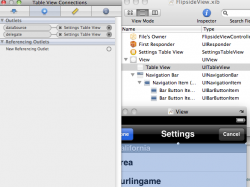Hello again,
This is a pretty fundamental question and I don't get how it works.
I have been coding away at individual chunks of an app and I've come to the point where I need to pull stuff together and I've run in to a wall here. I realize I may have been doing this completely wrong to this point.....
My base app consist of a main view with an info button. hit the info button and we flip over to a new view with a navigation controller on top that has 2 buttons. - simple.
I also have a UITableViewController where all the cool stuff is happening. I want to put the UITableView of this UITableViewController into what is left of the UIView below the navigation bar.
I have added the controller to the nib but how do I get the 'table view' under 'Settings Table View' to sit on my view?
I have tried to add a new table view to the view and linked up the delegate & dataSource. (screenie 2). This is not working and is crashing but without any messages. I imagine that the TableViewController is not initialized.
I've kindof hit the wall here. How do I do this?
Back to basics as well, have I been doing this right or should I have approached this completely different?
This is a pretty fundamental question and I don't get how it works.
I have been coding away at individual chunks of an app and I've come to the point where I need to pull stuff together and I've run in to a wall here. I realize I may have been doing this completely wrong to this point.....
My base app consist of a main view with an info button. hit the info button and we flip over to a new view with a navigation controller on top that has 2 buttons. - simple.
I also have a UITableViewController where all the cool stuff is happening. I want to put the UITableView of this UITableViewController into what is left of the UIView below the navigation bar.
I have added the controller to the nib but how do I get the 'table view' under 'Settings Table View' to sit on my view?
I have tried to add a new table view to the view and linked up the delegate & dataSource. (screenie 2). This is not working and is crashing but without any messages. I imagine that the TableViewController is not initialized.
I've kindof hit the wall here. How do I do this?
Back to basics as well, have I been doing this right or should I have approached this completely different?



